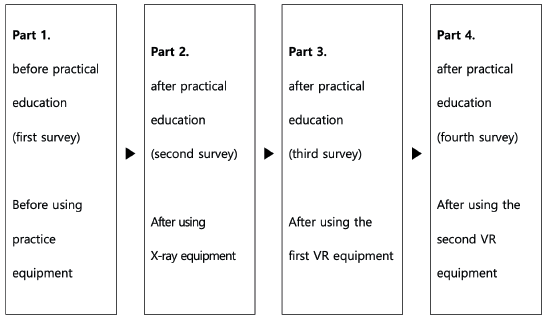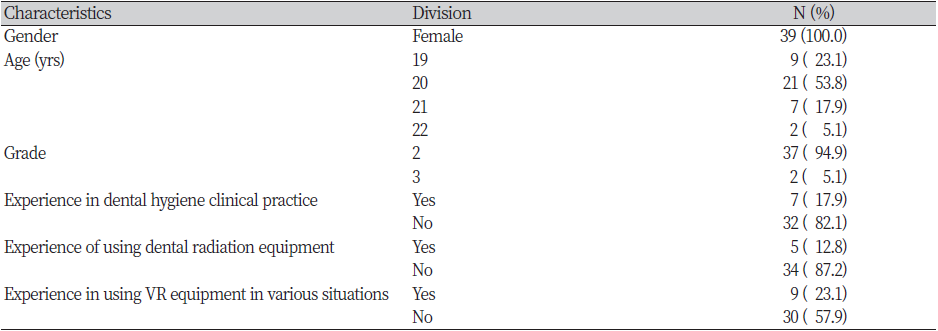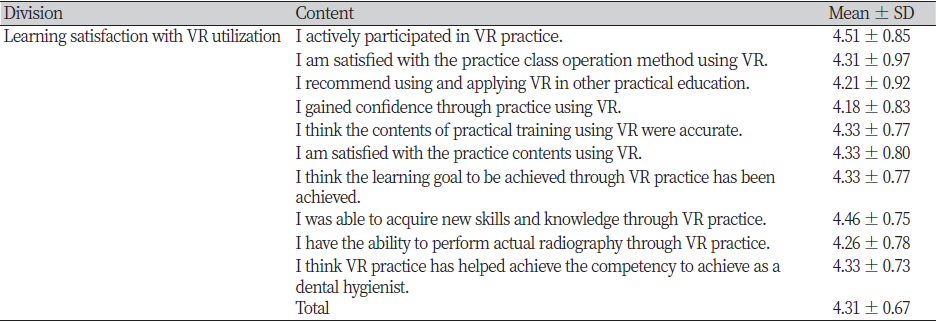Introduction
Virtual reality (VR) is a specific environment or scenario that is similar to reality or refers to the technology itself, created by humans using artificial technology and computers. The virtual environments and scenarios stimulate the user’s five senses and enable interaction [1]. Recently, the development and application of VR media for education have attracted significant interest of researchers [2]. During the COVID-19 pandemic, classrooms rapidly transitioned to the online environment. Consequently, pressure on educational institutions for online delivery has increased [3,4], leading to increased interest in VR technology [5]. Additionally, there was a significant demand for the development of educational platforms using VR that enable anyone to easily participate and work in the non-face-to-face environment [6]. VR media enables users to interact with other users in various forms [7], which is why it is used for various purposes [8,9]. In education, the visualization, interaction, and control characteristics of VR are used in many ways, enabling individualized learning, collaboration, and problem-solving learning [10,11]. Additionally, VR is increasingly used as educational media in dentistry and dental hygiene. In dentistry education, VR technology is used to support clinical practice education by developing various clinical situations and problems for indirect experience to overcome the limitations of existing practice education for tooth extraction [12]. Moreover, VR learning environments have been developed for non-face-to-face dental clinical practice [13], and VR is also used to create environments that allow users to communicate with patients as prospective dentists and simulate oral healthcare activities [14].
In dental hygiene, studies have used VR media for learning periodontal instruments used in state examination practical tests to assess the effects of self-practice in the non-face-to-face environment [15]. Additionally, as part of the professional University inovation support project, a total of eight professional colleges for dental hygiene are jointly developing VR-based oral anatomy contents for changes in the college education environment post-COVID-19 [16]. The education environment of dentistry and dental hygiene has undergone changes with time and circumstances, and studies have reported the benefits of VR in education [17,18]. However, there is still a lack of studies on VR for dental hygiene education. In particular, in dental hygiene, VR is mostly used for only basic academic topics such as anatomy [19].
Therefore, the purpose of this study was to use VR educational media in oral imaging practice class for dental hygiene students and evaluate the learning interest, learning commitment, and learning motivation of the students to provide basic data necessary for the potential use of VR in various dental hygiene classes and development of innovative practical training courses in the future.
Methods
1. Participants
This study was approved by the Institutional Review Board (IRB) of 00 University (IRB No: SM-202010-070-2). The participants of this study were second-year students in the second semester of 2020 who registered for oral imaging and practical courses. The purpose and method of this study were explained to the students, and only those who provided a written consent were included in the study. A total of 42 second-year students registered for the class, and 39 students, excluding those who did not agree to participate or did not complete the consent form, were included in the final analysis.
2. Methods
1) VR application in oral imaging practice class
The oral imaging practice class aimed to help students learn imaging techniques and understand the basic practice necessary for oral radiography as well as principles, imaging, and development of oral radiography. The class focused on student-centered activities to help the students develop photos and learn from mistakes during intra- and extra-oral radiography. The class was an elective major (3 credits) and comprised both online and offline lectures. Theory and practice were taught separately. VR educational media was only used in oral imaging practice class during weeks 11 and 12 after the midterm exams. <Table 1> shows the progress of the class at the time of this research.
2) VR educational media device
A dental radiography simulator (Rs_Dental) by VRAD was used for VR educational media in this study. The virtual reality-based radiography simulation provided an environment where the students could practice imaging in VR without being exposed to radiation <Fig. 1>.
3) Research tool
A research tool with verified reliability and validity in a previous study [20] was modified and supplemented for use in this study. The questionnaire items evaluated general characteristics (6 items), learning interest (4 items), learning commitment (9 items), learning motivation (5 items), educational media preference (4 items), and learning satisfaction (10 items). The items were self-administered and evaluated on a 5-point Likert scale from 1 to 5. Cronbach’s α for learning interest, learning commitment, learning motivation, and learning satisfaction was 0.897, 0.872, 0.893, and 0.957 respectively.
4) Research questionnaire progress flow
The questionnaire was completed a total of four times by the participants: before the oral imaging practice class; after traditional X-ray device practice; and after practice using VR educational media device <Fig. 2>. The same items of the questionnaire were used every time.
3. Data analysis
IBM SPSS program (ver. 25.0; IBM Corp., Armonk, NY, USA) was used for statistical analysis. Descriptive statistics were performed to calculate the frequency, percentage, mean, and standard deviation. The Kolmogorov–Smirnov analysis was performed for normality testing of the sample size. As normal distribution was not satisfied (p>0.05), a non-parametric analysis was conducted. As differences before practice and between the media were variables with a continuous flow of time, Friedman two-way ANOVA by ran was performed for non-parametric analysis of repeated measures ANOVA. Subsequently, the non-parametric post-hoc test was performed, and the Bonferroni correction was applied for analysis. Differences in learning interest, learning commitment, and learning motivation by general information of the participants between the two groups after the end of the final oral imaging practice were analyzed through the Mann–Whitney analysis. The Spearman correction test was conducted for the correlation between VR education satisfaction and learning interest, learning commitment, and learning motivation. A p-value less than 0.05 was considered statistically significant.
Results
1. General characteristics of study participants
<Table 2> shows the general information of the study participants. Approximately 82.1% of the participants did not have experience of dental hygiene clinical practice, and 87.2% did not have experience of using dental radiology equipment. Approximately 57.9% of the participants had no experience of using VR media devices.
2. Differences in learning interest, learning commitment, and learning motivation by oral imaging practice educational medium
<Table 3> shows the results of analysis of the mean differences in learning interest, learning commitment, and learning motivation by oral imaging practice educational medium. There were significant differences in learning interest, learning commitment, and learning motivation by oral imaging practice educational media (p<0.05). Learning interest was the highest after the first use of VR device, and learning commitment and motivation were the highest after using X-ray equipment.
|
Table 3. Differences in learning interest, learning immersion, and learning motivation by type of oral radiology practice education Unit: Mean±SD (N=39) 
|
*by Bonferroni’s test after Friedman’s test
3. Differences in learning interest, learning commitment, and learning motivation by general information
<Table 4> shows the results of analysis of differences in learning interest, learning commitment, and learning motivation by general information from the participants. The analysis was conducted using the scores at the end of the second VR practical training. For the experience of VR equipment used in various situations, learning interest (4.52 points), learning commitment (4.27 points), and learning motivation (4.52 points) were high in the inexperienced group; however, there was no statistical significance. Similarly, groups with clinical practice experience and experience using dental radiation equipment showed high learning commitment after VR learning, but the difference was not statistically significant.
4. Learning satisfaction with VR and educational media preference in oral imaging practice class
<Table 5> shows the results of learning satisfaction with VR practice after class. The item “I actively participated in VR practice” had the highest score (4.51 points), whereas “I recommend using and applying VR in other practical education” had the relatively lowest score (4.21 points). The score for overall learning satisfaction with VR use was 4.31 points.
<Table 6> shows the results of analysis of the correlation between learning satisfaction with VR use, learning interest, learning commitment, and learning motivation in an oral imaging practice class. The correlation coefficient for correlation between VR learning satisfaction and learning interest, learning commitment, and learning motivation was rs=0.611, rs=0.666, and rs=0.642, respectively, indicating positive correlations (p<0.01). This showed that learning interest, commitment, and motivation increased significantly as VR learning satisfaction increased.
<Table 7> shows the preference for oral imaging practice educational media. The participants showed a relatively low preference for theory classes alone, believing that learning satisfaction could be achieved when theory and practice were integrated. Moreover, the participants preferred using only X-ray equipment to using only VR devices. They showed the highest preference for using both X-ray equipment and VR devices as practical educational mediums with a score of 4.44 points.
Discussion
Following the 4th industrial evolution and the COVID-19 pandemic, VR is actively used for various purposes. In particular, there is increasing interest in the use of VR in education. In the context of such social and historical changes, VR is expected to be used even more in dental hygiene education [6-9]. Therefore, this study aimed to use VR in dental imaging practice classes to evaluate students’ perceptions and VR’s educational effects to provide basic data for the possible diverse uses of VR in dental hygiene education.
Herein, we analyzed differences in learning interest, learning commitment, and learning motivation of participants by oral imaging practice educational media and observed positive improvements in learning perception after using practical educational media. Additionally, post-hoc analysis showed significant improvement in learning perception after X-ray device use and second use of VR device compared to that before practical training. This implied that VR could derive educational effects when used in practical training involving the direct participation of students using educational medium and devices suitable for the subject of interest. VR use also led to significant improvements after use. These results show that effective learning can be achieved in learners when an educational media suitable for periodical changes is adequately combined with the learning topic’s characteristics [20]. Shin et al. [21] previously reported that dental hygiene practice often only involves observation despite having many practical contents, and argued that more effective practice methods are needed for improvement. Therefore, VR devices and similar media that enable virtual experiences to supplement the physical practice environment and lack of face-to-face practice may be suitable alternatives.
Virtual spaces and VR are convenient and efficient tools to induce and control learners’ interest by using various educational contents through immediate interaction with instructors and allowing learners to freely experience the learning environment [22]. As shown in <Table 4>, although the difference was insignificant, learners with no experience of clinical practice, X-ray equipment use, and VR device use showed higher overall scores for learning effect perception than those who had the experience. Therefore, learners may have higher learning effects when they have no prior experiences. New VR education content integrating conventional practice methods and the unique characteristics of each subject would enable learners to gain greater learning effects.
Our findings also showed significant correlations between VR learning satisfaction and learning interest, learning commitment, and learning motivation. In a previous study, Gu and Lee [23] analyzed learning interest, learning commitment, and practice satisfaction to verify the development and effectiveness of augmented reality dental radiography simulation. In the group that used the augmented reality simulator, learning interest, learning commitment, and practice satisfaction were higher than in the group that did not use the augmented reality simulator. These results imply that augmented reality-based learning medium promote learning interest [24], inducing learning motivation for active participation in learning activities. In other studies, augmented reality was reported to not only simulate the senses of learners, but also provide an adequate learning environment for learners, significantly increasing learning commitment [25]. Furthermore, Cho and Chung [26] reported an association between learning satisfaction and learning commitment in students to suggest that new teaching designs that can improve learner satisfaction are needed for instructors. As such, previous studies reported findings that were in agreement with our results on learning satisfaction, learning interest, learning commitment, and learning motivation.
Therefore, in using educational media such as VR, instructors need to consider the virtuous cycle of learning and implement new teaching strategies based on a clear understanding of the new medium that can improve learning satisfaction. However, new technologies and devices such as the VR media may also only elicit spontaneous curiosity and preference and fail to promote continuous and in-depth learning interest, commitment, and motivation in learners [20]. Thus, instructors must focus on using VR devices that can enhance learning interest, commitment, and motivation in the learners rather than focusing on conveying the concept of VR. Professional teaching strategies and detailed teaching designs that can reflect the physical characteristics of VR devices as well as the uniqueness of the subject, adequacy of contents, and effectiveness would be necessary. This is consistent with the results in Table 7, which showed that the item “oral imaging practice can achieve sufficient learning satisfaction through practical classes that use a combination of X-ray and VR devices as the educational medium” had the highest response rate. In oral imaging practice class, learners were interested in using new technology such as VR devices, but also showed significantly improved learning interest, learning commitment, and learning motivation after hands-on experiences with traditional X-ray devices such as inserting the films in the oral cavity and controlling the devices for practice. This suggests that VR devices may have more significant outcomes on learning interest, learning commitment, and learning motivation when VR is combined with traditional practice media for complementary effects.
Several limitations must be considered in the interpretation of this study’s findings. As this case study targeted dental hygiene students of certain regions, the findings cannot be generalized. Moreover, this study did not provide evidence for the validity and effectiveness of the VR device. During the study, interactions over the study period could not be excluded, and thus, the mutual interaction between the results cannot be differentiated. Additionally, the VR device was not applied with a systematic teaching design during the entire semester. Instead, VR was only used for a short-term of two weeks. Therefore, it is difficult to predict changes in the reaction and perception of students after long-term use. The learning effects were also not based on objective academic achievement, but rather focused on subjective changes in perception. In future studies, such limitations must be complemented. However, this study is meaningful as it observed the potential use of VR devices in oral imaging practice classes when there is a lack of studies on VR device used in dental hygiene education. This study also provided basic data for the implementation of VR content in future dental hygiene education.
Conclusions
This study used VR educational media in oral imaging practice classes for dental hygiene students and evaluated changes in learning interest, learning commitment, and learning motivation. Additionally, it aimed to provide basic data for the application of VR educational media in dental hygiene education and obtained the following results.
1. VR media use in oral imaging practice class induced positive changes in learning interest, learning commitment, and learning motivation of students. There were significant improvements in the scores of learning interest, learning commitment, and learning motivation after using VR educational media (p>0.05).
2. In oral imaging practice class, the correlation coefficients between VR learning satisfaction and learning interest, learning commitment, and learning motivation were rs=0.611, rs=0.666, and rs=0.642, respectively. As VR learning satisfaction increased, learning interest, learning commitment, and learning motivation also significantly increased (p<0.01).
3. The students’ preference for oral imaging practice educational media was as follows: they did not prefer theory classes alone. Instead, they showed the highest level of preference for integrating X-ray and VR devices for practical educational media with a score of 4.44 points.
Based on these findings, VR educational media can promote learning interest, commitment, and motivation in students in oral imaging practice classes. VR educational media integrated with X-ray devices in mixed face-to-face and non-face-to-face settings would help to achieve positive effects of oral imaging practice learning.










